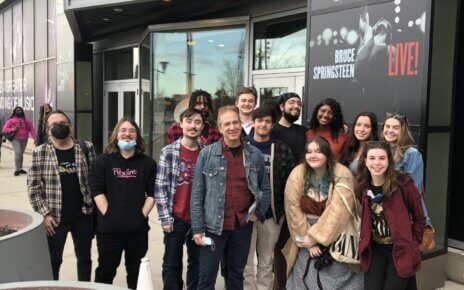The mountain lion known as P-22 looked majestic just a few months ago in a trail-camera photo shot against the backdrop of the Hollywood sign.
But when a remote camera in Griffith Park captured an image of the puma more recently, it showed a thinner and mangy animal. Scientists sedated him and drew blood samples. They found evidence of exposure to rat poisons.
Now, researchers say they suspect a link between the poisons and the mange, a parasitic skin disease that causes crusting and skin lesions and has contributed to the deaths of scores of bobcats and coyotes. A National Park Service biologist applied a topical treatment for mange and injected Vitamin K to offset the effects of poisoning.
The condition of California’s famous cougar is likely to intensify the debate over the use of rat poisons in areas of the state where urban living collides with nature.
Nearly 20 municipalities throughout California, including San Francisco, Calabasas and Malibu, have passed resolutions urging residents not to purchase and businesses not to sell “second-generation” anticoagulant rodenticides, said Jonathan Evans, a staff attorney with the Center for Biological Diversity, a nonprofit group based in San Francisco. P-22 was afflicted by two older “first-generation” rat poisons, which he probably ingested by eating other wildlife.
The maker of d-CON, a leading rat poison, is fighting efforts to ban sales of its product to consumers, arguing that it is safe when properly used. The company contends that by eliminating consumer access to one type of effective, affordable rodent control, California runs the risk of increasing the use of alternative products that contain powerful _ and potentially more harmful _ neurotoxins.
During nearly two decades of research in and around the Santa Monica Mountains National Recreation Area, park service scientists have documented widespread exposure in carnivores to common household poisons. Of 140 bobcats, coyotes and mountain lions evaluated, 88 percent tested positive for one or more anticoagulant compounds. Scores of animals are known to have died from internal bleeding, researchers said.
The poisons also affect protected or endangered species including golden eagles, northern spotted owls and San Joaquin kit foxes.
In wide use in parks, schools and homes, rat poisons are designed to kill rodents by thinning the blood and preventing clotting. Many people who set bait traps do not realize the poisons work their way up the food chain, researchers say.
Los Angeles Councilmen Paul Koretz and Tom LaBonge have asked the city’s Department of Recreation and Parks to report on the use of poisons to control rodents.
In Malibu, activists Kian and Joel Schulman of the Malibu Agricultural Society pushed for the local resolution and have used photos of distressed and dead animals to successfully lobby store managers and restaurateurs to stop selling or using rat poisons.
Kian Schulman routinely prowls the perimeters of shopping centers in search of broken bait boxes near trash bins filled with food waste. At her urging, Pepperdine University phased out the use of all rodenticides on its Malibu campus. It uses live traps and will consider installing raptor perches to encourage natural rodent control, said Rhiannon Bailard, with the school’s Center for Sustainability, Governmental and Regulatory Affairs.
The California Coastal Commission this month approved new planning guidelines for the Santa Monica Mountains that include a call for stopping the use of rodenticides. The plan also immediately bans in unincorporated areas the use of anticoagulant poisons that are the most harmful to bobcats, coyotes and mountain lions.
The most sweeping action to date was taken in March, when the state Department of Pesticide Regulation signaled plans to halt retail sales of second-generation anticoagulant rodenticides to consumers. Under the rules, slated to take effect July 1, only licensed specialists could purchase and use them.
Reckitt Benckiser Group, which makes d-CON, is seeking a preliminary injunction against the rules. The company said the “new regulation will unnecessarily put Californians at an increased public health risk from rodent infestation and place a greater financial burden on families and individuals who cannot afford professional pest control services.”
Second-generation rodenticides are dangerous even when animals ingest them in sublethal doses. The anticoagulant makes them lethargic, wildlife experts say, so they are more likely to die from exposure or be hit by cars.
The activism and regulation have centered around second-generation poisons, but older first-generation poisons also remain of concern. Those poisons were commonly used decades ago until many rodents developed an immunity. But first-generation poison can still be harmful to wildlife.
Mange is caused by a microscopic mite that burrows into the skin and causes itchiness and skin lesions. The afflicted animal loses fluids and nutrients through the skin. Complications including infection, starvation and hypothermia eventually lead to death.
The connection between exposure to anticoagulant rodenticide and mange is not fully understood, said Seth Riley, a wildlife ecologist with the Santa Monica Mountains National Recreation Area.
Mange in wild cats is rare. A decade ago, researchers documented two mountain lion deaths in the Simi Hills that they blamed on poisoning by anticoagulant rodenticides. Both had mange.
Scientists said P-22’s condition does not appear to pose a safety threat to human beings. He continues to spend most of his time in the park’s most remote areas, said Jeff Sikich, a National Park Service biologist who has tracked P-22’s activity. Shortly before he was recaptured, P-22 had killed an adult buck.

